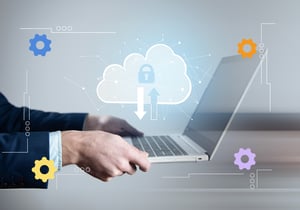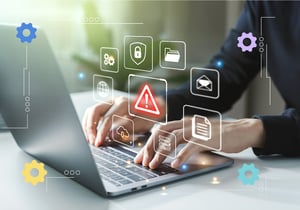KEY TAKEAWAYS
The shift to remote work has delivered significant benefits for employees and organizations — but it’s also introduced new security challenges. Protecting data in remote work environments is essential to safeguarding sensitive information, preventing unauthorized access, and ensuring business continuity. As remote work evolves, understanding and addressing the risks is more important than ever.
Key Threats in Data Security for Remote Work Environments
Public Wi-Fi Risks
Public Wi-Fi networks, while convenient, are often unsecured and pose several risks. Hackers can intercept data transmitted over these networks, potentially capturing sensitive information such as login credentials and personal data. Cybercriminals may also inject malware into connected devices or intercept communications between users and websites, launching man-in-the-middle attacks to steal data and compromise systems. Without proper security measures, passwords and other confidential information can be accessed by malicious actors sniffing data transmissions, leading to unauthorized access and data breaches.
Public Cloud Vulnerabilities
Using public cloud services for remote work can also introduce vulnerabilities. Incorrectly configured cloud settings may expose sensitive data to unauthorized users, increasing the likelihood of breaches and potential financial or reputational harm. Weak authentication protocols and inadequate security controls in cloud environments can allow malware to spread or enable unauthorized access. Attackers can exploit insecure interfaces and APIs to exfiltrate data or gain deeper access, leading to significant data loss and security incidents.
A targeted cloud security assessment can help uncover hidden risks — from misconfigured storage and lax access controls to overlooked identity and authentication gaps — and offer clear, actionable steps to harden your remote cloud environment.
Regulatory Expectations and Remote Work Data Protection Compliance
Importance of a Risk Assessment
Regular risk assessments are essential to identifying and mitigating risks associated with remote work. This includes evaluating the security posture of your remote work setup and pinpointing potential vulnerabilities, ensuring continuous protection against emerging threats. It’s equally important to assess the security controls of third-party vendors and partners who access your systems remotely, as their weaknesses can directly impact your organization's security.
Strong Authentication and Encryption
Implementing robust authentication and encryption is critical for protecting remote work environments. Multifactor authentication (MFA) provides an extra layer of security by requiring multiple forms of verification before access is granted, significantly reducing the risk of unauthorized access. Encrypting data in transit helps ensure that sensitive information is not intercepted, even when transmitted over public or unsecured networks.

Policies and Controls for Securing Remote Work
Password Management
Strong password practices are foundational to securing remote work environments. Encourage employees to create complex passwords and update them regularly to reduce the risk of unauthorized access. Password managers can help employees generate and securely store strong, unique passwords, reducing the likelihood of password reuse and enhancing overall security.
Home Network Security for Remote Workers
Securing home networks is vital to protect against external threats. Advise employees to use secure networks with strong passwords and encryption. Wherever possible, they should avoid using public Wi-Fi for work-related tasks. Implementing VPNs and creating separate network segments for work-related activities can reduce exposure by isolating sensitive data from personal traffic.
Endpoint Protection
Protecting devices used by remote workers is crucial for maintaining overall security. Ensure all devices have up-to-date antimalware software and firewalls to defend against threats. Mobile device management (MDM) solutions can help manage and secure work devices, enforce policies, and remotely wipe data if necessary.
Access Controls
Limiting access to critical systems and data minimizes the risk of breaches. Restrict administrative privileges to reduce the potential impact of unauthorized changes or malware infections. A least-privilege approach ensures that users only have access to the systems and data required for their roles.
Monitoring and Logging
Continuous monitoring and logging are essential for detecting and responding to security incidents. Maintaining detailed logs of network activity enables security teams to identify suspicious behavior and respond effectively. Security information and event management (SIEM) tools can aggregate and analyze data from various sources, offering a comprehensive view of your security posture and supporting faster incident response.
Training and Awareness for Remote Workers
Effective Training Programs
Educating employees on security best practices is crucial for maintaining a secure remote work environment.
Regular training keeps employees informed about current threats and the steps they should take to protect sensitive data. Phishing simulations and security drills reinforce key lessons and help gauge readiness, building a stronger cybersecurity culture.
Maintaining Communication
Ongoing communication helps maintain security and cohesion across remote teams. Schedule regular check-ins to share updates, answer questions, and ensure everyone is aligned on security protocols. Foster an environment where employees feel comfortable reporting issues or asking for help when they spot something suspicious, ensuring that potential threats are identified and addressed promptly.
Your Next Steps Toward a More Secure Remote Environment
Securing remote work environments is essential to protecting sensitive data and maintaining business continuity.
By understanding key risks, aligning with regulatory expectations, implementing strong controls, and reinforcing a culture of security through training and communication, organizations can strengthen their defenses against the growing number of threats targeting remote teams.
![]()
Remote Teams, Resilient Defenses

Cloud environments are complex, with vulnerabilities that can change rapidly. A cloud security assessment identifies risks before they become major issues.
Read More
Has your organization migrated to M365? Is it secure? Build confidence in the security of your cloud data with a Microsoft 365 Hardening Assessment.
Read More


.png?width=400&name=SBSIWebinarsBundles_WebMenu%20(1).png)
